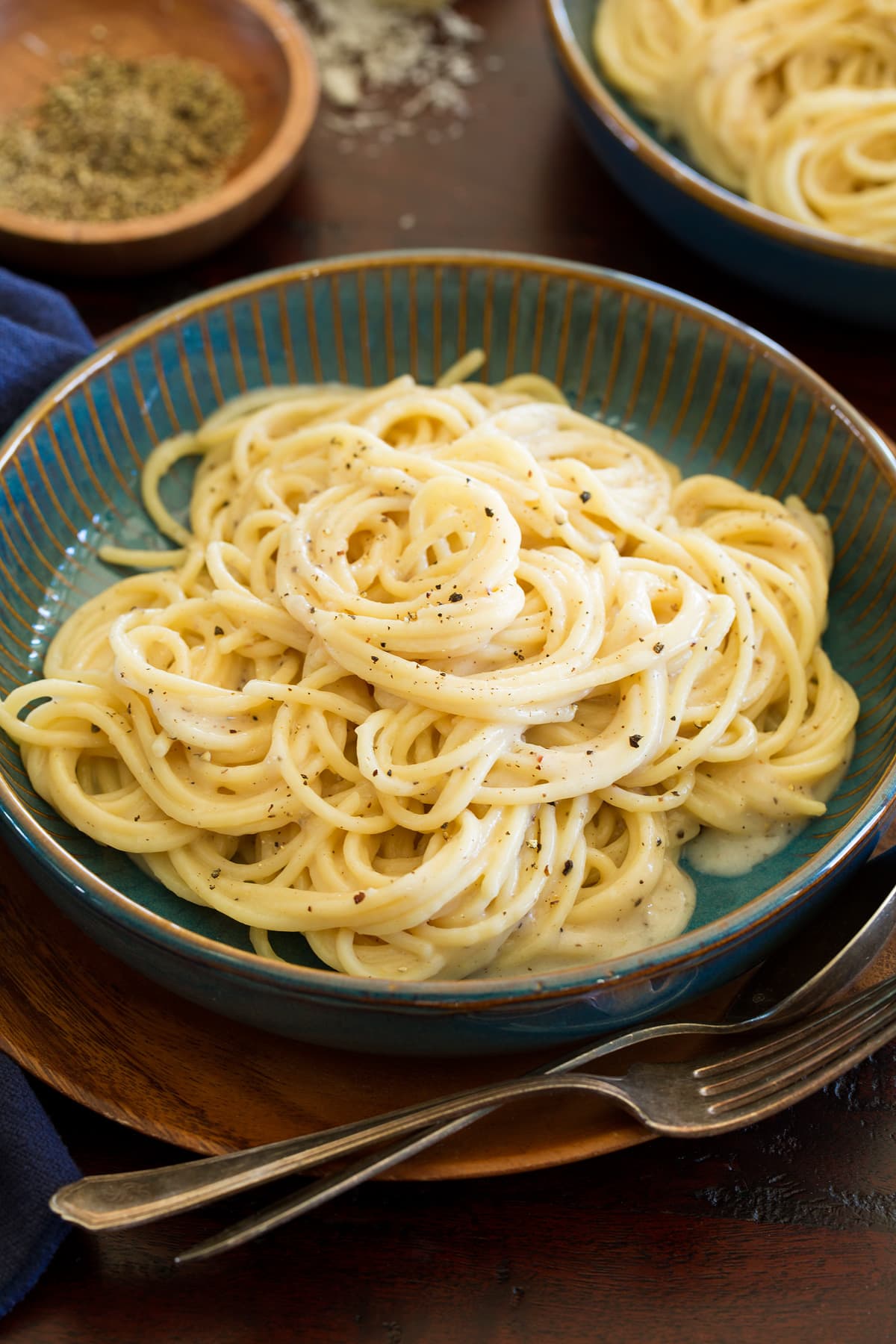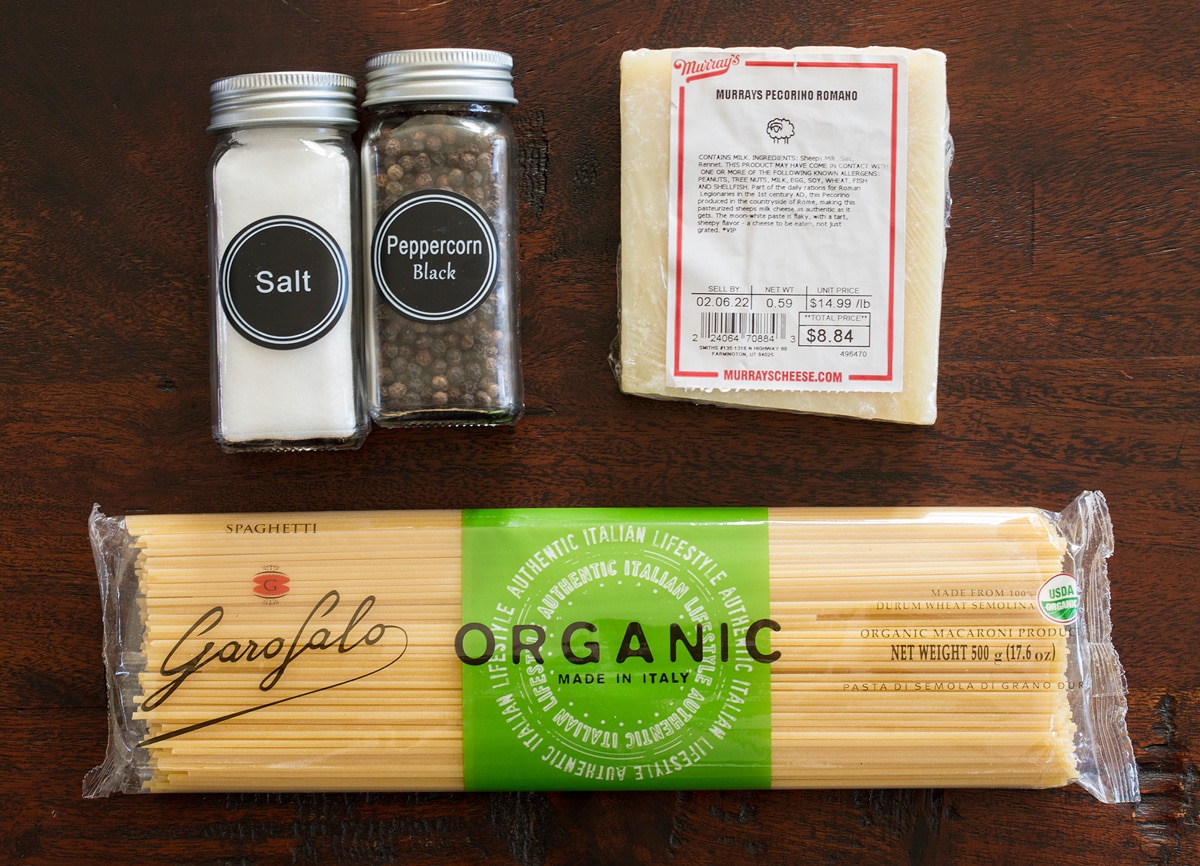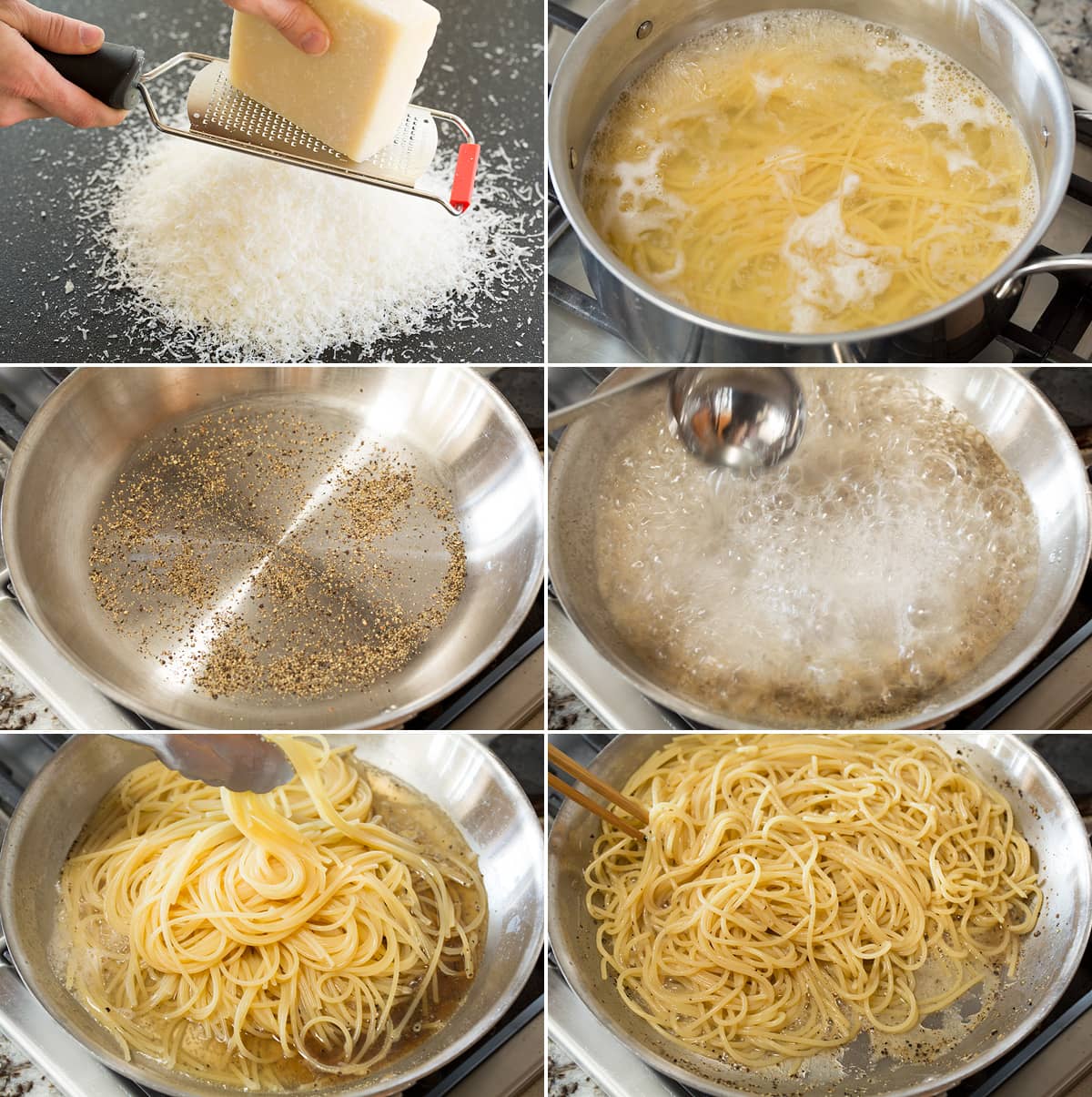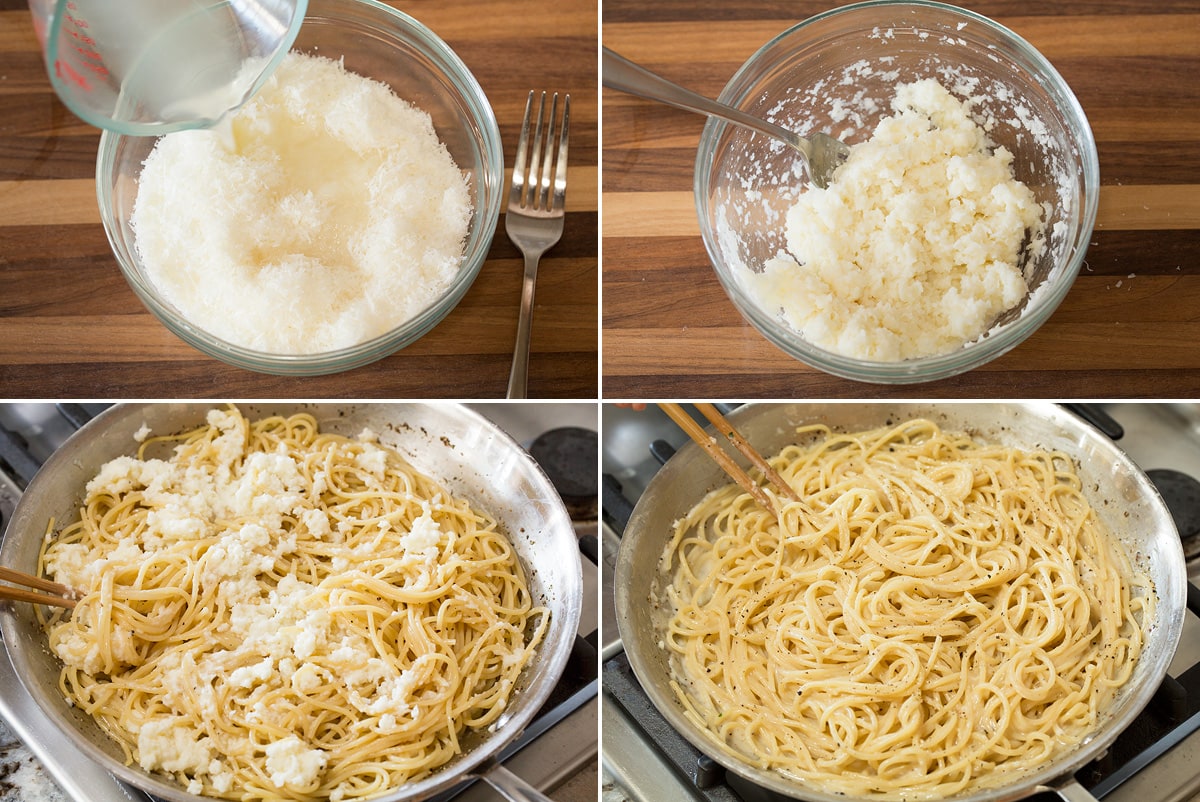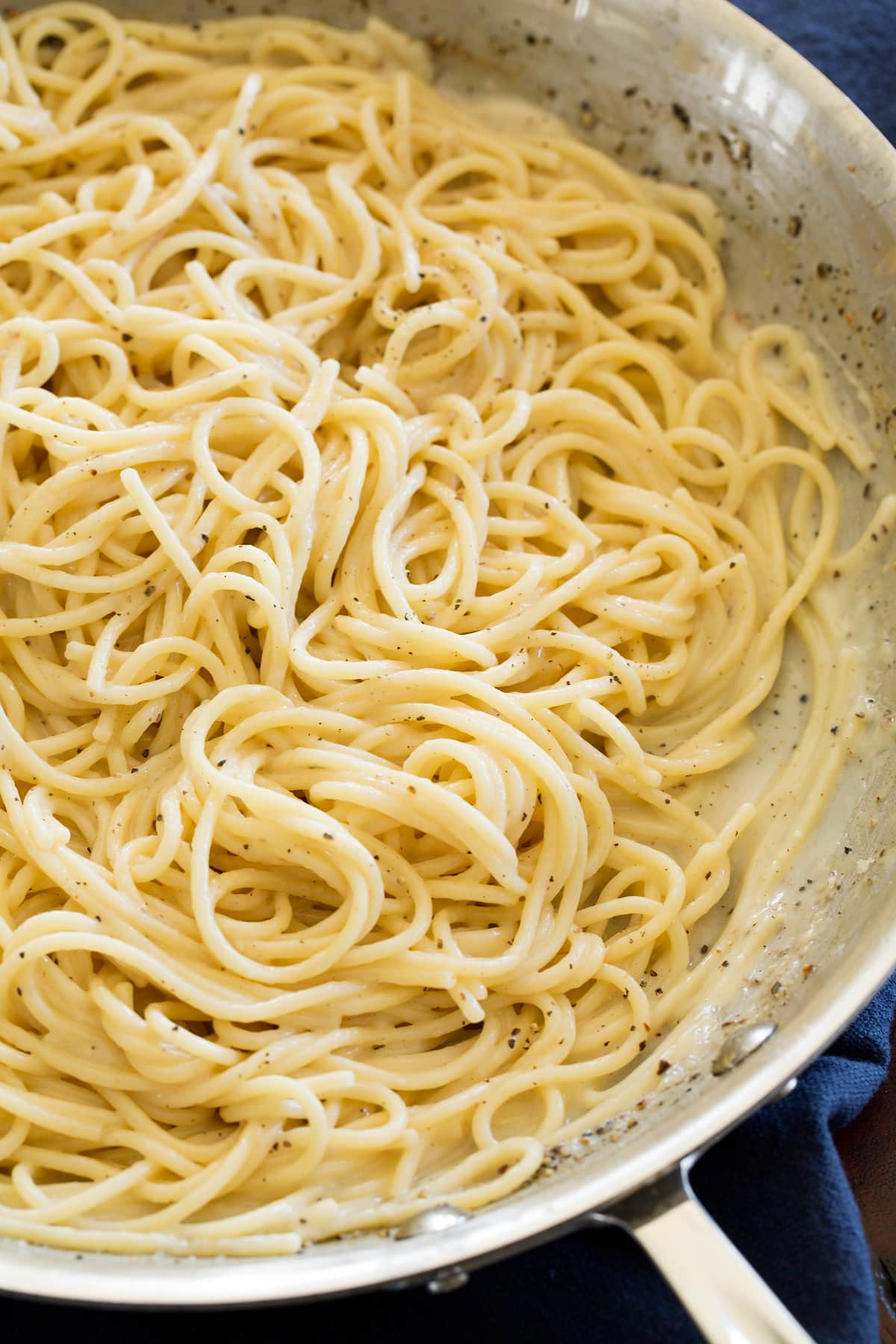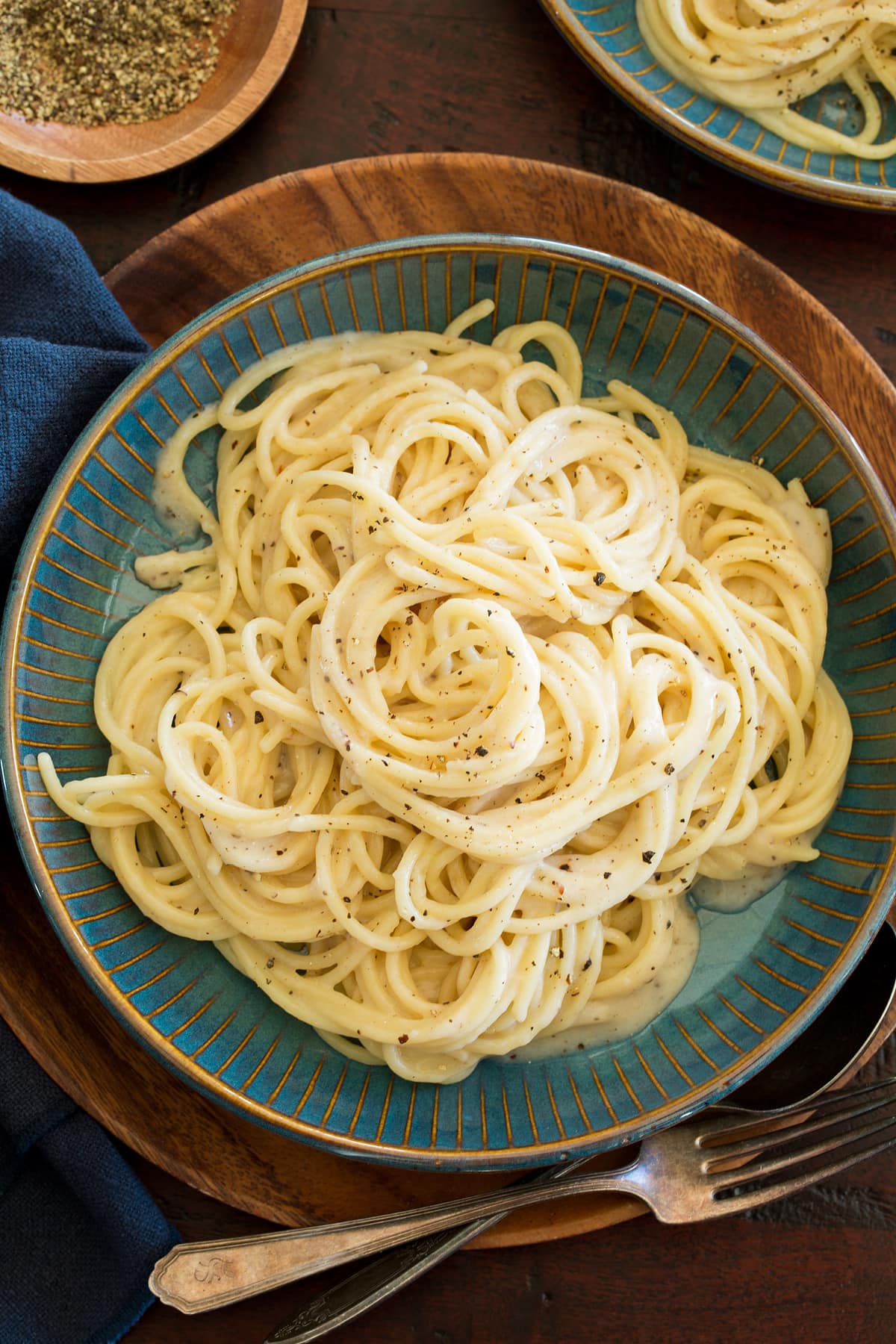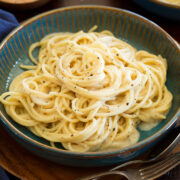Cacio e Pepe
This post may contain affiliate links. Read our disclosure policy.
Easy, authentic, and creamy Cacio e Pepe! Made with just 3 ingredients including pasta, Romano cheese and black pepper. It’s such a humble yet impressive dish with unmistakably delicious flavor!
What is Cacio e Pepe?
Cacio e pepe is an inexpensive pasta dish that originated from Rome, Italy. Cacio e pepe translates from Italian to English as “cheese and pepper” which is the basis of the sauce.
It is pronounced ‘ca-cho ee peh pay.’ You may think of the texture and taste being reminiscent to alfredo or mac and cheese.
When made authentically it only requires pasta (such as spaghetti, bucatini or tonnarelli), Pecorino Romano cheese, cracked black pepper, salt, and the boiled pasta water.
The process of preparing it is quite simple:
- Pasta is boiled until it starts to soften, just a little over halfway cooked.
- Then it’s transferred to a skillet with some of the pasta cooking water and there it cooks a bit longer (this two pan cooking approach is to concentrate that starchy water further so it acts as a really great binder).
- From there a cheese paste is made with the Romano cheese and some pasta water, and that is added to the pasta off heat and tossed to melt.
It’s such an easy recipe that’s a dinner game changer for a quick, light prep dish that will never disappoint. Plus it’s a recipe with maximum flavor built off only 2 basic ingredients – plus salt and pepper.
The key here is to follow the method closely. It took me quite some time to perfect this dish and achieve a smooth rich sauce (no clumping!) – especially without the need of adding any oil or butter (which is not authentic).
But as written, following all the steps closely, you should be right on your way to success!
Cacio e Pepe Recipe Ingredients
- 10 oz. bronze cut spaghetti
- Salt
- 1 1/2 tsp coarsely ground black pepper, or to taste
- 4 oz. Pecorino Romano cheese, thinly grated with a rasp grater
How to Make Cacio e Pepe
- Boil water in pot: Pour 7 cups warm water into a large pot. Bring to a boil over medium-high heat and season with salt (I use 1.5 tsp).
- Cook pasta partially: Once it boils add pasta and cook about 1/3 shy of the al dente time listed on the package (so if it lists 10 to 11 minutes cook about 7). Do not drain pasta water!
- Toast pepper in skillet: When pasta is almost done add pepper to a 12-inch skillet and heat over medium-low heat until lightly toasted, tossing occasionally, about 2 minutes.
- Add pasta water to skillet: Using a ladle (the long handle will prevent steam burns), pour 1 cup water pasta water from spaghetti pot into skillet. Then set aside 1/4 cup pasta water by cheese to cool slightly.
- Toss pasta in skillet and finish cooking: Add the nearly cooked pasta to skillet and cook and toss very frequently until pasta is just al dente, about 5 minutes, while adding more pasta water a half ladle at a time as needed to thin.
- Cool slightly: Remove from heat and let the pan and pasta cool for 1 – 2 minutes so the cheese doesn’t clump from excess heat.
- Make cheese “paste”: Meanwhile add the Romano cheese to a medium bowl. Pour in that 1/4 cup pasta water into cheese and stir with a fork to blend.
- Toss cheese mixture and pasta: Pour cheese mixture over pasta. Toss to melt and coat the pasta with cheese while adding more pasta water from pot to thin as needed.
- Serve right away for the best consistency (as it cools the sauce will thicken quite a bit).
Tips for the Best Cacio e Pepe
- Only use an Italian imported Pecorino Romano, others likely won’t work well here and the flavor will be lacking.
- Use a rasp style grater to finely grate the cheese so it melts quickly and easily.
- For best results use a bronze cut spaghetti, this specific type will release more starches which will help bind the sauce and pasta more adequately.
- Stick with the amount of water listed to cook the pasta. Any more and you’ll drowned it out. You want a smallish amount for a more concentrated starch content.
- Do not drain the pasta in a colander, you want that pasta water nearby because you’ll use a fair amount of it throughout the process. Use tongs or a pasta ladle to remove it right from the boiling pot of water and transferring to the skillet.
- Keep to the step of toasting the pepper first for an extra layer of flavor.
- Use chopsticks or long kitchen tweezers (if you have them) when tossing the pasta in the skillet so pasta doesn’t break so easily. Tongs and other tools don’t work quite as well.
- Let the pasta cool off heat just slightly before adding the cheese mixture. Otherwise it can overheat and clump up from the overly-hot residual heat of the pan.
- As it rests it thickens so you can thin with more pasta water as needed.
Possible Variations
Those these aren’t traditional it can be a helpful way to switch things up based on what you have on hand.
- Use a different long strand pasta in place of spaghetti such as the bucatini, tonnarelli, linguine, fettuccine, vermicelli, or capellini.
- Add a cooked protein such as shrimp, chicken, pancetta or bacon.
- Try it with Parmigiano Reggiano cheese in place of Pecorino Romano cheese.
How to Reheat
- Of course this dish is best the day it’s made but any extra is still delicious the next day too, the consistency is just thicker.
- Just rewarm individual servings in the microwave until heated through. Preferably toss halfway through heating.
More Classic Italian Favorites to Try
Follow Cooking Classy
Cacio e Pepe
Ingredients
- 10 oz. bronze cut spaghetti
- Salt
- 1 1/2 tsp coarsely ground black pepper, or to taste
- 4 oz. Pecorino Romano cheese, finely grated
Instructions
- Pour 7 cups warm water into a large pot. Bring to a boil over medium-high heat and season with salt (I use 1.5 tsp).
- Once it boils add pasta and cook about 1/3 shy of the al dente time listed on the package (so if it lists 10 to 11 minutes cook about 7). Do not drain pasta water!
- When pasta is almost done add pepper to a 12-inch skillet and heat over medium-low heat until lightly toasted, tossing frequently, about 2 minutes.
- Using a ladle (the long handle will prevent steam burns), pour 1 cup water pasta water from spaghetti pot into skillet with pepper. Then scoop out and set aside 1/4 cup pasta water by cheese to cool.
- Add the nearly cooked pasta to skillet and cook and toss very frequently until pasta is just al dente, about 5 minutes, while adding more pasta water a half ladle at a time as needed to thin (it shouldn't ever be dry, there should be some excess moisture).
- Remove from heat and let the skillet and pasta cool for 1 - 2 minutes.
- Meanwhile add the Romano cheese to a medium bowl. Pour in that 1/4 cup pasta water into cheese and stir with a fork to blend.
- Pour cheese mixture over pasta. Toss to melt and coat the pasta with cheese while adding more pasta water from pot to thin as needed.
- Serve right away.
Notes
- Only use an Italian imported Pecorino Romano, others likely won't work well here and the flavor will be lacking.
- Use a rasp style grater to finely grate the cheese so it melts quickly and easily.
- For best results use a bronze cut spaghetti, this specific type will release more starches which will help bind the sauce and pasta more adequately.
- Stick with the amount of water listed to cook the pasta. Any more and you'll drowned it out. You want a smallish amount for a more concentrated starch content.
- Do not drain the pasta in a colander, you want that pasta water nearby because you'll use a fair amount of it throughout the process. Use tongs or a pasta ladle to remove it right from the boiling pot of water and transferring to the skillet.
- Keep to the step of toasting the pepper first for that extra layer of flavor.
- Use chopsticks or long kitchen tweezers (if you have them) when tossing the pasta in the skillet so pasta doesn't break so easily. Tongs and other tools don't work quite as well.
- Let the pasta cool off heat just slightly before adding the cheese mixture. Otherwise it can overheat and clump up from the overly hot residual heat of the pan.
- As it rests it thickens so you can thin with more pasta water as needed.
